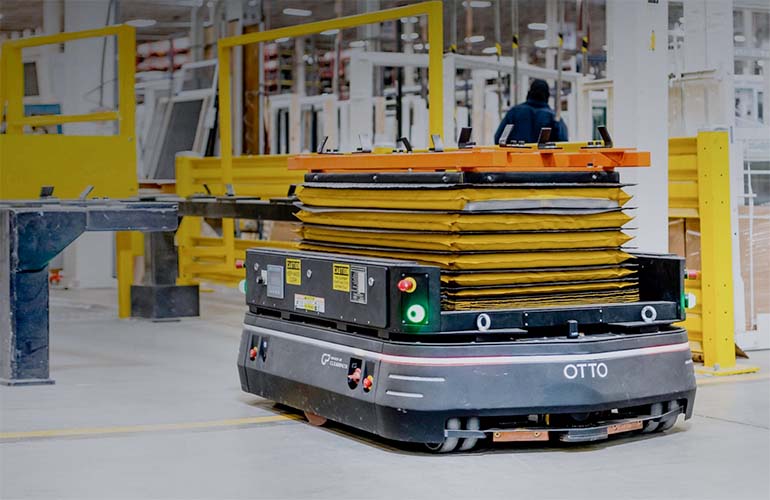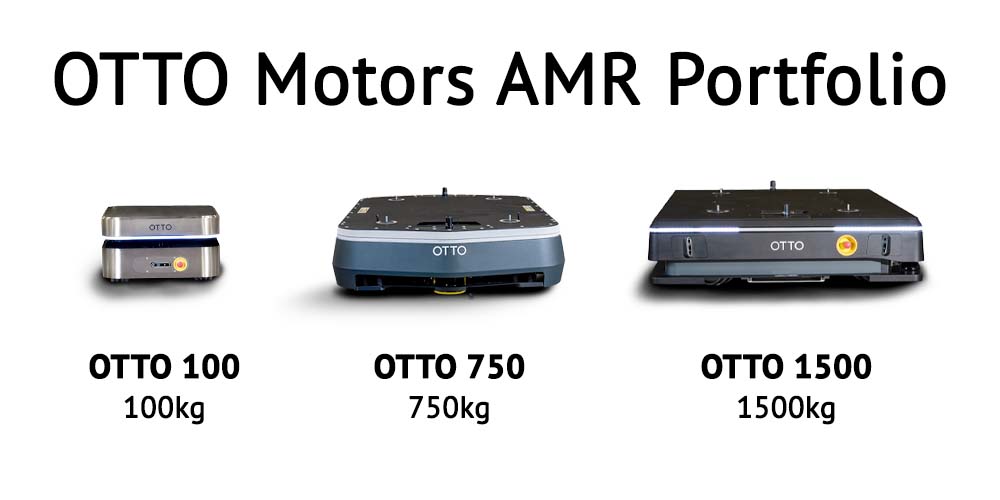|
Listen to this article  |

Q&A: Matt Rendall, co-founder, OTTO Motors
OTTO Motors is a Kitchener, Ontario-based spin-off of Clearpath Robotics. Clearpath is a developer of autonomous mobile robots (AMR) for research and development purposes founded in 2008.

Matt Rendall, CEO and Co-founder, OTTO Motors
Around 2013, Clearpath noticed patterns that R&D was starting to pick up in material handling. The pattern became too hard to ignore around 2014, when it started to build the first business plans for OTTO Motors.
Fast forward to today, OTTO Motors is a leading autonomous material handling company serving global markets focused primarily in automotive, as well as food and beverage, consumer packaged goods and other heavy industrial applications.
We recently sat down with OTTO Motors co-founder and CEO Matt Rendall to discuss the current state of the autonomous mobile robotics market and the importance of simulation in helping customers deploy AMRs.
Editor’s Note: This interview was excerpted from Rendall’s recent appearance on The Robot Report Podcast. It has been edited for length and clarity. To catch the entire conversation with Rendall, check out the latest episode of The Robot Report Podcast.
Oitzman: Your portfolio today for OTTO has evolved to include three different configurations: a 100 kg payload, a 750 kg payload and a 1500 lg payload. Tell us a little bit about the evolution of your AMR portfolio and the type applications that are important for each of those different payload configurations?
Rendall: Figuring out the right payloads and form factors was something that we spent quite a bit of time early on thinking about. Ultimately, as we started researching material handling, one of the things that became very clear to us very early on was just how deep the domain expertise of material handling truly is, and how varied it is not only from industry to industry, but even from automotive plant to automotive plant within the same company.
We also knew that we were autonomous vehicle people, we were roboticists, we knew a ton about autonomy, but not a lot about material handling. So, we decided if we’re going to take a crack at this, let’s start with the closest thing we can identify to a universal standard for material transport.
That’s how we zeroed in on the pallet. We figured if we created an autonomous pallet mover, that would open up the most doors for us in very beginning.
And even still today, we tend to lead in the heavy payload AMR category, it’s a very different technical problem to solve (from the smaller payload solutions). When you’re moving that much mass at speed, the inertia inside of that system creates a very different safety problem to address within production environments.

OTTO Motors portfolio includes three different sized AMRs, each engineered for a specific class of material handling. | Credit: OTTO Motors
And from there, the closest universal standard for material transport is actually human motive power. There are just very practical upper bounds on how much weight a human can push before they tap out. The OTTO 100 tends to be really well served to human scale, payload transportation.
Then you have the Goldilocks problem where the OTTO 100 is a little bit too small for some tasks, and the OTTO 1500 is a little bit too large for some tasks. So the OTTO 750 fits right in the middle.
We have the OTTO 100 that can move human scale loads, the OTTO 750 that can move pump truck scale loads, and the OTTO 1500, which can move forklifts scale loads. Those really are the three most common techniques employed in material handling for transporting material. That’s how the portfolio came to be.
For industrial robotics, the integration channels are very strong, yet, I have seen very few of those companies invest in selling mobile robotics. What’s your take on using integrators to help sell and install AMR solutions?
Rendall: For us, it’s also been a learning process for the industry. Systems integrators are, generally speaking, always looking for differentiation and competitive advantage. So being able to offer a new form of automation that not all of their peers are offering is something that often gets us a first conversation (with a new partner).
Most systems integrators are in the business of producing discrete process automation. The manufacturing world has spent the last 40 years investing, installing, optimizing, and perfecting machines that do one thing or two or three things very fast.
The ability to connect islands of automation with autonomous material handling gives you a more streamlined and automated flow, and a more completely automated value chain.
Material handling is one of the least automated things inside of highly automated businesses. That’s part of what we’ve been investing in over the last three or four years to just make sure we surround our certified partners with the tools and people needed to successfully compete and win projects to connect those islands of automation.
We (at The Robot Report) are excited to have you as a keynote speaker at the upcoming Robotics Summit in May, 2022, in Boston. You’re on the hook to talk about simulation. Can you give us a taste of how you are using simulation in your business today?
Rendall: Simulation is such an important part of not only the planning process for designing an autonomous material handling system, but the ongoing operation of it as well.
It wasn’t something that we set out to do at the very beginning when we were developing the OTTO 1500. Simulation came as a result of bumps and bruises in the first deployments that we were experiencing in 2015-2016.
Half of the problem was asking ourselves what happens if the vehicle moves a little bit faster or slower than we expect? What does that do to our fleet count? How does that impact productivity?
We experienced some projects in the 2015-2016 time frame where customers would develop a business case with us, we would install an AMR fleet, only to expose a process bottleneck slightly upstream. And if you experience a process bottle necking slightly upstream, it doesn’t matter how great the ROI case is for what you’ve installed, you’re not going to realize it.
It became existential for us to solve more of a holistic process design to ensure that the upstream and downstream bottlenecks, whether it’s starvation, or accumulation of goods, is not going to impede the success of the AMR program.
Customers would ask: “Oh, what if I did this or that to my AMR fleet?”
So we’ve been investing in building our simulation capabilities as a strategic differentiator for our business since about 2016. We’ve got a combination of industry standard, discrete event, process simulation tools. There’s a couple that industrial engineers and process engineers rely upon, we’ve been building out our libraries of AMR processes for about 6-7 years, so we’ve got a pretty sophisticated portfolio that we’re able to pull from.
There’s always going to be something you didn’t anticipate. So being able to fuzz the simulation to just understand how resilient your solution is to whatever source of chaos is introduced. You know that that “measure twice, cut once” or “an ounce of prevention is worth a pound of cure” type of mentality is part of the reason why today the majority of the work that we do is business critical 24 by 7 operations where seconds matter in the delivery chain.
A good manual process does not make for a good automated process by default. So we really try to zoom out and identify the best process. And by trying to identify the best process, we can help our customers identify the ideal state or the ideal solution.
So I think what I heard you describe for us is that there’s three big use case buckets for simulation: first, there’s the use case for sales and application engineers to use and during the sales process. Second, the use case for your engineering team, to actually run simulation about product changes to the product, to understand how that’s gonna impact the overall performance characteristics of the of the robots. And third, the fleet management use case where tweaking things during production and validating actual performance before pushing parameter changes to the fleet?
Rendall: There’s one modifier that I would offer to the first bucket on the sale, resales or, the concept development side of things: there are brownfield projects and there are greenfield projects.
The vast majority of projects are brownfield. You’ve got a facility that’s been online for 40 or 50 years. As part of the continuous improvement program, there’s an automation mandate to do new things with material handling. So the task at hand is: “how do we commission an AMR fleet to solve delivery routes A, B, C, D?”
Then on the other side of the equation, you’ve got greenfield opportunities. A greenfield opportunity is a blank page. When you encounter a greenfield, you have this remarkable opportunity to rewrite the playbook for manufacturing or rewrite the playbook for warehousing.
This is where the factory or distribution center of the future concept rubber hits the road. And when you have a really, really strong competence in simulation and process design, actually, I would say process design, first and then simulation to validate the processes that you’re contemplating. You can partner at the blueprint level of the manufacturing operation.
We’ve collaborated with customers to redefine how plants are laid out, how aisle ways are sized, what the arteries look like for transportation and we’ve been able to achieve better productivity per square foot by rethinking how plants are laid out where the primary mode of transportation is material handling.
So that’s a very, very different problem to solve than a brownfield and goes so far beyond your kind of typical definition of application engineering for a brownfield program. But when you do tackle those projects, the impact that you can have as an AMR provider, and what we validated in some of the early green fields that we’ve been involved in, is you can achieve productivity gains that brownfield sites could never achieve.
It’s profound, and it’s all enabled by simulation.
Before I let you go, I wanted to capture your thoughts about some of the various AMR acquisitions over this past year?
Rendall: I am a huge supporter of the transactions that are happening. It’s just a massive validator, that the market trends that we started picking up on in 2015 are materializing to the point where mainstay automation brands are putting serious dollars on the table to acquire a strategic capability.
I think it’s only going to serve to accelerate the market. The last five years, I would still say we’re in the early adopter phase. The stakes are high in automation. So the tolerance for failure is low and that leads to a risk averse mentality in industry.
So if ABB is offering an AMR capability, it’s going to bring more risk-averse buyers to the table. That’s a good thing for the industry.
I would still say we are in the early days. I think there’s going to be a lot more acquisitions on the horizon from a market consolidation perspective. I’m just generally really excited about the patterns that are starting to unfold.
Editor Notes: You can listen to the full interview with Matt Rendall on the latest episode of the The Robot Report Podcast.
To catch Matt’s keynote on the state of simulation in robotics, be sure to register for the upcoming Robot Summit and Expo in Boston, on May 10-11, 2022.
Credit: Source link


Comments are closed.